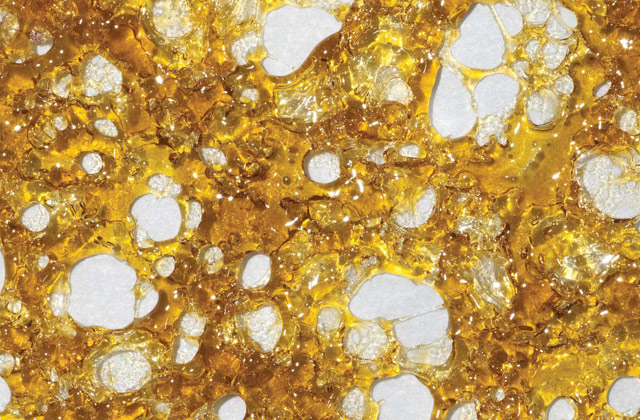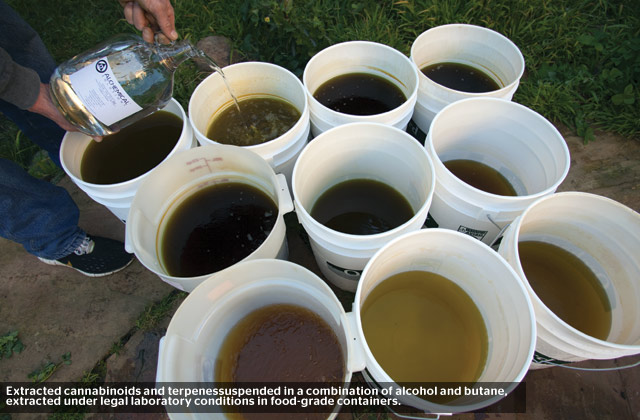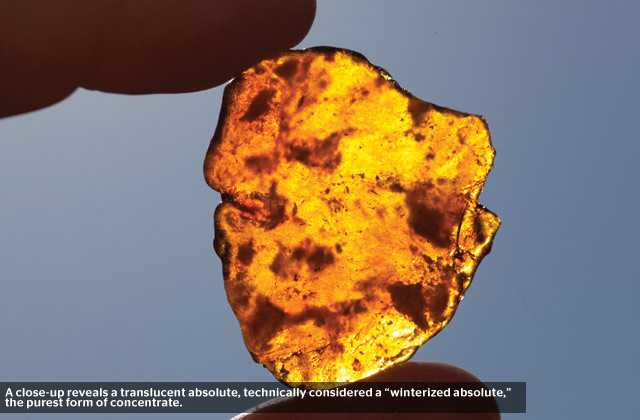- Joined
- Sep 1, 2014
- Messages
- 13,062
- Reputation
- 5,346
- Reaction score
- 46,333
- Points
- 0
- Currently Smoking
- yo arse

The Art and Science of Cleaning Concentrates: Part One
BY K. OF TRICHOME TECHNOLOGIES AND MEL FRANK · WED JUN 19, 2013
Before we begin, please note that this article was written for professional concentrate manufacturers with the goal of helping them to create cleaner, healthier products. Some people have foolishly attempted to make concentrates using cans of butane meant for lighter refills and have badly burned or injured themselves in the process, even causing explosions; those who survived have faced prosecution on serious criminal charges. Further, consumers need to be forewarned that ingesting such amateurishly made extracts can have long-term health consequences. Because solvents are highly flammable, potentially explosive and dangerous to work with, we believe extraction should be left to the professionals. Therefore, the initial extraction process will not be described in this article, which focuses on ways to improve the purging and cleaning of extracted cannabis resin.
An Introduction to Concentrates
High Times Cannabis Cups now recognize concentrated forms of extracts as an increasingly important category in their competitions. Popularly known as dabs or dabbing, these concentrates are a very hot ticket: Vendor booths featuring them draw the most attention at High Times events, and concentrate panels garner some of the biggest crowds at panel discussions. But while concentrates aren't new, the cannabis concentrate industry is -- and it's also standing at an important juncture in the changing attitudes toward marijuana in this country. As a result, if this new (and at times naïve) concentrate industry doesn't become better self-regulated, it could well prove a detriment to the future of cannabis legalization.
First, a few basic points: Dabs are very small amounts of concentrated cannabis resin. The main constituents of this resin are cannabinoids (such as THC and CBD, which are responsible for the plant's euphoric and medicinal properties), as well as the various terpenes and terpenoids (which are responsible for the myriad flavors and aromas we experience in marijuana). Terpenes and terpenoids also contribute, via the so-called "entourage effect," to the perceived differences in psychoactivity of different marijuana strains.
Hashish is the traditional non-solvent concentrate; whether it's hand-rubbed, sieved or water-extracted, hash is basically a collection of resin glands (also called trichomes) and plant debris. Even the best sieved and water-extracted hash will contain some plant debris, and hand-rubbed hash even more so. But in properly made solvent concentrates, this plant debris (along with the resin-gland heads and stalks) is eliminated. Well-made concentrates consist only of the resin from the trichomes, which is made up of cannabinoids and essential oils. Concentrates are attractive for important health reasons: For medicinal use, they can provide measured quantities in products with known cannabinoid levels, while for recreational users, they allow ingestion with a minimum of smoke and fewer inhalations.
Manufacturers of concentrates apply various names to their wares, but these actually comprise only three concentrate forms: shatter (or glass), budder (or wax), and honey oil (or BHO, a.k.a. butane hash oil). Products such as edibles and balms made with concentrates are generally referred to as infusions. But highly varied labels are given to concentrates as people rename and repurpose these three basic forms. For example, a seller might hammer a shatter (or glass) into a fine powder, then package and label it as "moon dust," "caviar" or some other novel name. It's not a new substance -- it's still made from the same original material -- but it has been turned into a powder and renamed for marketing purposes.
In the pharmaceutical and chemical industries, a plant-derived concentrate is classified as a Botanical Drug Substance (BDS); the professional term absolute is "glass" or "shatter" in our market, and a concrete is what is commonly referred to as "budder" or "whipped BHO."

Another Note of Caution
For both manufacturers and consumers, it's extremely important to realize that a concentrated extract contains everything that was soluble in the material used. This can include pesticides or fertilizers sprayed on the plant, resulting in users or patients ingesting massive doses of potentially harmful contaminants. Given this fact, the consumer should always take care to determine that the starting material was grown free of pesticides and foliar sprays.
Our goal is to educate both manufacturers and consumers by explaining the processes that produce the purest, healthiest concentrates possible. A search through existing cannabis-extraction patents will yield much useful information for manufacturers. Most, if not all, of today's marijuana-extraction methods were discovered years ago. There is no secret or proprietary method involved here, and no current concentrate maker has "invented" anything; it's all just the same chemical processes discovered long ago. None of the methods described here are new (see plantlipids.com). A highly recommended instructional DVD to start with is available for purchase from medicinalalchemy.com. This article brings together information from a number of these sources.
Cleansing Your Concentrate Extraction
Two methods of cleaning or "purging" concentrates after the initial extraction are discussed here. However, we caution people to use only top-quality buds (either fresh or dried) in the initial extraction in order to ensure the healthiest, most potent finished product. Remember, never use buds from plants that were sprayed with neem oil, pesticides or fungicides, or that were kept near a sulfur burner -- and you should especially be sure that your buds are free of pests, mold or mildew. Good, clean buds make good, clean product, so know your source!
The following sections outline methods by which extract artists can clean or purge their product of unwanted and unhealthy byproducts left over from the initial extraction. These byproducts may include (but are not limited to) residual solvents from the extraction that get trapped in the cannabis resin, as well as undesirable plant material such as chlorophyll, fats and lipids. Not only are these very unhealthy, but they also make for a harsh and unpleasant smoke. While many amateur concentrate makers believe their job is done after the initial extraction, true extract artists should understand the science behind the following processes and know that these methods are just as important -- if not more so -- than the initial extraction.

Method I: Winterization
Winterization treats concentrated resin that was extracted using butane, nitrogen or CO2 as the primary initial solvent. It doesn't matter which fluid is used, as all three generally yield good quality and considerable quantities of cannabinoids, terpenes and terpenoids. Also, all three at least minimally strip unwanted substances, such as chlorophyll, lipids, fats and plant waxes, from the cuticles (the shiny coating on leaf surfaces).
If CO2 or nitrogen was used in the extraction, the raw extract should be placed in ethanol alcohol (for example, the grape-spirit ethanol available from organicalcohol.com) and then warmed slightly to approximately 120°F, until you see the extract dissolve into the grape spirits.
When using butane, mix one part grape spirits with two parts butane, and the cannabinoids will migrate to the alcohol while the butane is evaporating. For this procedure, start with instrument-grade N-butane as the primary extraction fluid, and then introduce the alcohol.
As seen in the first photograph, we start with multiple containers full of one part alcohol to two parts cannabinoid-infused butane. If you don't understand how we got to this point, then this process is not for you. A lack of knowledge and understanding can have catastrophic consequences, such as explosions and fires. However, if you're a manufacturer who already understands how we got to the full containers, this is what comes next:

After you've infused the cannabinoids into the organic alcohol, pour the solution into sealable containers. WARNING: At this point, all of the butane, nitrogen or CO2 must be completely evaporated. To repeat: Do not put anything into the containers until all of the butane, nitrogen or CO2 has completely evaporated; once it has, the fluid will no longer bubble when stirred. Essentially, the fluid is now a very strong tincture.
Next, seal the containers of alcohol solution and place them into a freezer (this step is called winterizing) for at least 24 hours at a minimum temperature of 32°F. But for a complete winterization, the solution should be frozen at -15°C to -25°C (13°F to 5°F) for 48 to 54 hours.
After winterization, pour the alcohol solution through unbleached organic coffee filters (or 20-micron filters) to remove the waxes and other undesirable elements that remain in it. This sediment will collect at the bottom of the solvent container, so carefully decant only the fluid into the filter, since you don't want to pour out the sediment as well. Also, never exceed the half-full line in the filter, as increased pressure from the fluid weight in a filled filter forces unwanted material through. So, to repeat: The procedure is to half-fill the filter, then drain it, discard the filter and replace it with a new one.


After proper filtration, what's left is a pure alcohol-infused extract. To simplify the drying and collecting, filter the extract directly into a pan or container lined with unbleached parchment paper. To recover the cannabinoids trapped in the sediment in the solvent container, refill it with alcohol and heat to 100°F before refreezing and then repeating the filtration process.
Next, the filtered solution must be dried. Place the pans in front of fans in a clean, dust-free environment with no light (even subdued light) and very good ventilation. Most importantly, be sure that there is absolutely no source of ignition, such as flames or sparks of any sort, including water heaters, dryers, refrigerators, electric tools, etc. And never flip on a light or any other kind of electrical switch. Be smart: There is no room for errors or carelessness in this line of work. Also remember that breathing alcohol vapor is unhealthy, so performing this part of the operation outdoors will greatly reduce your risk.

Drying, Vacuums & Temperature
The concentrate generally takes 24 to 48 hours to dry, depending on air movement, temperature and humidity. Do not apply heat, as it will slightly diminish the flavor by evaporating some of the lighter essential oils. When evaporating the alcohol, any remaining water should be evaporated as well; if this is not the case, let the concentrate stand until both are gone. This process is commonly referred to as thin-layer evaporation. The resulting product is sticky and runny but not yet fully dried, as it still has minute amounts of alcohol and water trapped inside. If this is slightly heated and vigorously stirred to release the alcohol and water, you will have an oleoresin, a mixture of oil and resin. This oleoresin still needs further drying.

Completely drying the oleoresin is a fairly straightforward process. The name commonly used for this procedure is "purging," but the scientific term is degassing. The proper method of degassing utilizes a vacuum drying oven, which allows for a very controlled application of heat under extreme vacuum. One excellent tool for this is the Model V from Across International (acrossinternational.com), which allows for the extreme vacuum levels needed to ensure a completely solvent-free Botanical Drug Substance. Also if desired, the vacuum drying oven can decarboxylate the BDS so that it can be used in edibles. The BDS will have only a minimal loss of terpenes and terpenoids, since when the heat is applied under vacuum, oxidation and degradation are reduced. You cannot achieve this type of vacuum in a jar.
The vacuum pump, plumbing and cold trap recommended here come in the "K" package available atvacuumpumpsupply.com. This pump also creates a high vacuum. The plumbing consists of metal clamps, screened centering rings, bellows (connector tubes), a filter and a cold trap. The cold trap is used to capture any alcohol or water before it contaminates the vacuum pump's oil, which could damage the pump or decrease its efficiency. The bottom chamber of the cold trap is filled with dry ice, and the top chamber can be filled with liquid nitrogen and then emptied out every three to four vacuum cycles to eliminate collected moisture. The cold trap is then refilled and the process repeated.

As always, read the instructions and understand the equipment. Place the undried BDS on the shelf of the vacuum drying oven and set the temperature on the oven to 60°C. A vacuum level of 8.0 millitorr is desirable, which develops fairly quickly. When the 8.0 millitorr is achieved, close the vacuum valve, turn off the pump and open the chamber door. Never exceed a temperature of 60°C or the product's color will darken and desirable extracts will be lost through overheating. So bring up the heat slowly to 60°C, while the pump brings the vacuum to the desired level. Close the vacuum valve when the temperature reaches the proper degree. The vacuum is released, and then the warm, wet BDS is taken out to cool in a dark, dust-free environment for approximately one hour.
After an hour, the BDS should be very hard and easy to flake off the parchment paper; if not -- if it's still soft and sticky -- then reheat, vacuum and cool until it is completely hard. Finally, fold the paper so that the BDS is bent upon itself until you've collected every single bit into one chunk. Mold this chunk into any convenient shape or form you want. I place the BDS into airtight, nitrogen-filled containers and freeze it for long-term storage. For short-term storage, I place it into an airtight/lightproof glass container and refrigerate.
This absolute/glass concentrate can be further processed into a concrete/budder one by placing it into a glass dish and warming to 120°F so that it begins to melt. At this point, it must be vigorously stirred or whipped until it reaches a light color and is non-sticky and putty-like in consistency. For stirring larger quantities, use a drill wrapped in a dust-free towel (so that no brush dust from the drill falls into the concentrate). It's recommended to use a hot plate for heating and reheating while stirring, which can take 10 to 15 minutes. This procedure is how a medicinally pure, winterized BDS can be produced on a large scale as either an absolute or a concrete.
Notes on Manufacturing Concentrates
Buds should be stored frozen and preferably never exposed to strong light after harvest, since exposure to light degrades some cannabinoids (particularly CBD), while exposure to air oxidizes THC to CBN, resulting in a lower-potency and darker-colored product. Many people believe that the darker the color, the poorer the BDS's ultimate quality, but this is simply not true. However, it is true that a lighter color indicates that the starting material was harvested, handled and stored properly. Even so, a darker color doesn't necessarily mean that the concentrate is bad or not very potent. A dark color only indicates that the starting material was harvested late or improperly stored and will be slightly less potent than it could have been. For example, one dark-red (almost black) BDS was amazing in both potency and flavor -- but it might have been even better if the starting product had been handled properly.
Also, the extract solution should never be exposed to light, especially direct sunlight, for any appreciable time. Sunlight, with its ultraviolet rays, will rapidly degrade the contents, resulting in a darker color, ranging from a cherry red to a dark purple that, in bulk, appears to be black. (And by "in bulk," we're talking about quarter-pound chunks and bigger, not paper-thin smears on parchment paper, which would be red, gold or a darker amber.) So high-quality buds that were stored in darkness -- and preferably frozen -- are the necessary foundation for making top-quality cannabinoid concentrates.

The Nuts & Nails of Safe Dabbing
The concentrate industry requires testing labs to produce reliable data on cannabinoid levels, but it also sorely needs labs to give cautions and recommendations on health issues. Questions concerning the means of ingestion are, as yet, unanswered. Is titanium a safe material to use? Are users inhaling flakes, gasses or compounds off heated nails and skillets? Titanium begins to become reactive at relatively low temperatures (400ºF), and common dabbing practice involves heating these skillets and nails to a cherry-red color, which happens at a much, much higher temperature.
Concentrates need to be tested for residual solvents and then safe levels established for these as well. Most labs simply do broad-spectrum pesticide/fungicide tests, but better tests are necessary for commonly used insecticides and fungicides such as neem oil, sulfur, and the organic substances commonly used in various insecticides and repellants. Just because a substance is labeled organic doesn't mean it's safe at concentrated levels. For consumers, the safest concentrates are produced by vertically integrated manufacturers -- those that grow their own marijuana and can reliably state that no pesticides or foliar sprays were used.
Editor's Note: Stay tuned for the second part of HIGH TIMES' mini-series on creating safe and healthy concentrates. Part II, appearing in the August 2013 issue now on newsstands and available digitally, will focus on another method for removing contaminants, developed by a longtime concentrate expert (and friend of the authors), Budderking.


